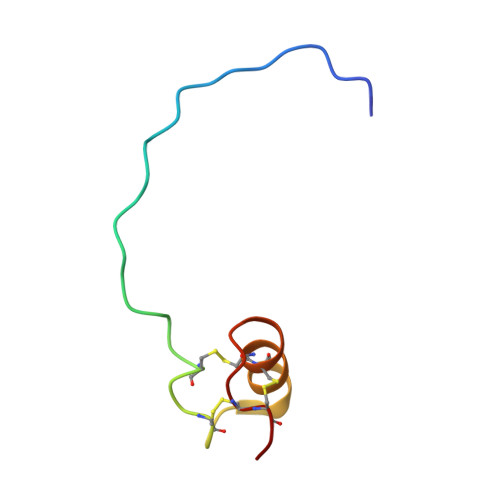Solution structure of synthetic penaeidin-4 with structural and functional comparisons to penaeidin-3
Cuthbertson, B.J., Yang, Y., Bachere, E., Bullesbach, E.E., Gross, P.S., Aumelas, A.(2005) J Biological Chem 280: 16009-16018
- PubMed: 15699044
- DOI: https://doi.org/10.1074/jbc.M412420200
- Primary Citation of Related Structures:
1XV3 - PubMed Abstract:
Antimicrobial peptide structure has direct implications for the complexity of functions and mechanisms of action. The penaeidin antimicrobial peptide family from shrimp is divided into multiple class designations based on primary structure. The penaeidin classes are not only characterized by variability in primary sequence but also by variation in target specificity and effectiveness. Whereas class 4 exhibits low isoform diversity within species and is highly conserved between species, the primary sequence of penaeidin class 3 is less conserved between species and exhibits considerable isoform diversity within species. All penaeidins, regardless of class or species, are composed of two dramatically different domains: an unconstrained proline-rich domain and a disulfide bond-stabilized cysteine-rich domain. The proline-rich domain varies in length and is generally less conserved, whereas the spacing and specific residue content of the cysteine-rich domain is more conserved. The structure of the synthetic penaeidin class 4 (PEN4-1) from Litopenaeus setiferus was analyzed using several approaches, including chemical mapping of disulfide bonds, circular dichroism analysis of secondary structural characteristics, and complete characterization of the solution structure of the peptide by proton NMR. L. setiferus PEN4-1 was then compared with the previously characterized structure of penaeidin class 3 from Litopenaeus vannamei. Moreover, the specificity of these antimicrobial peptides was examined through direct comparison of activity against a panel of microbes. The penaeidin classes differ in microbial target specificity, which correlates to variability in specific domain sequence. However, the tertiary structure of the cysteine-rich domain and indeed the overall structure of penaeidins are conserved across classes.
- Centre de Biochimie Structurale, CNRS UMR 5048, INSERM U414, Université Montpellier 1, Faculté de Pharmacie, 15 Avenue Charles Flahault, 34093 Montpellier Cedex 5, France.
Organizational Affiliation:
















